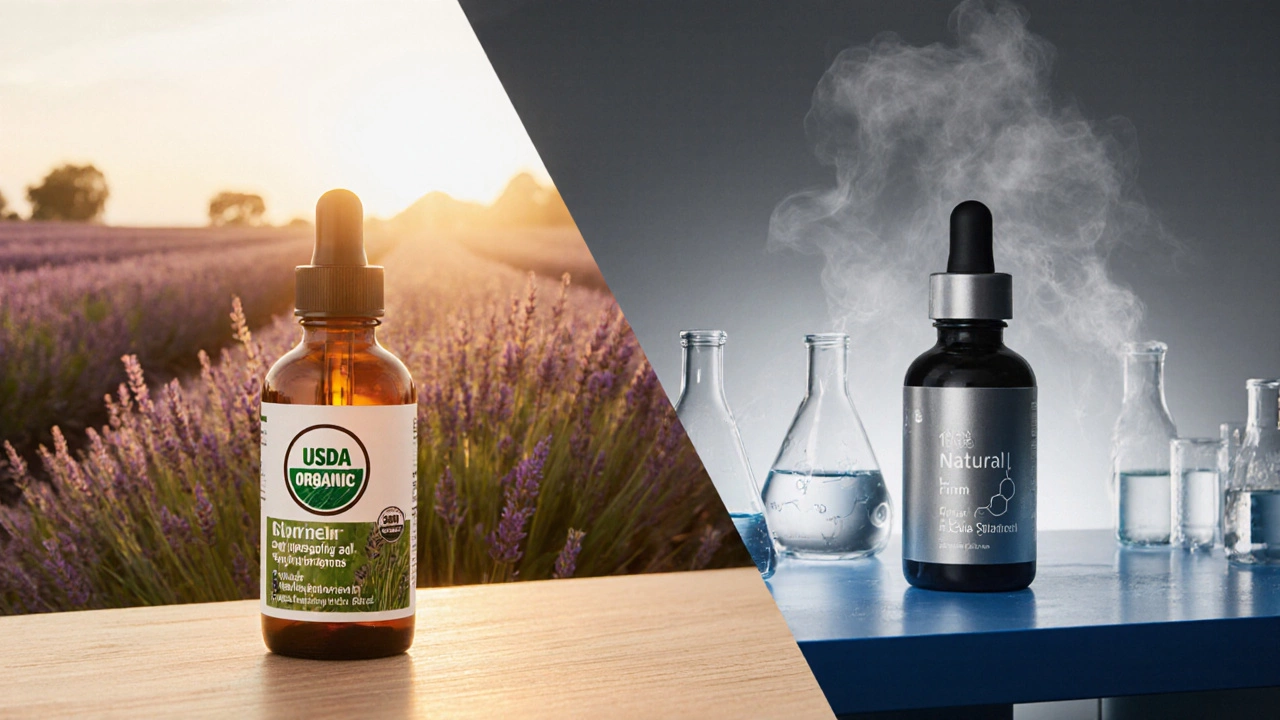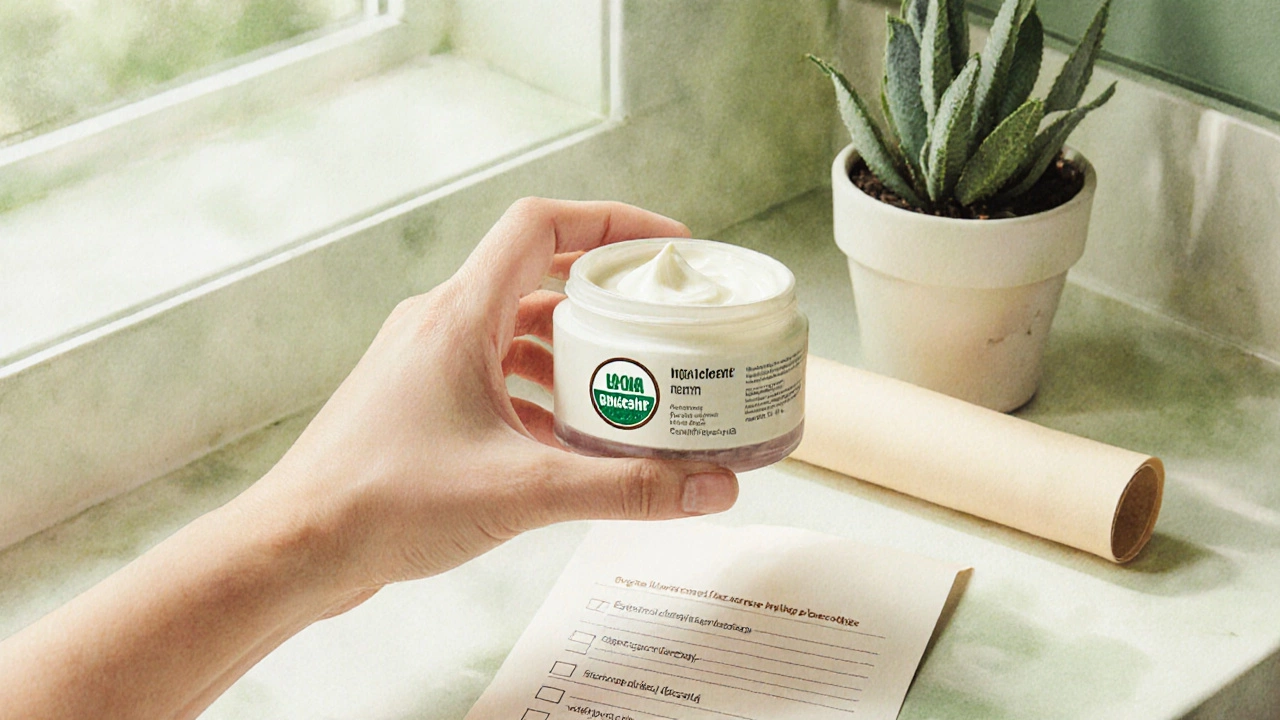Is Organic Skincare Really 100% Natural?
 Oct, 22 2025
Oct, 22 2025
Organic Skincare Certification Checker
Enter the percentage of organic ingredients in your skincare product and select the certification standard to see if it meets organic claims.
Enter the percentage and select a certification type to check your product's organic claim.
When you see Organic skincare is a category of skin‑care products formulated with ingredients grown without synthetic pesticides, fertilizers, or GMOs, and processed according to recognized organic certification standards, the first reaction is usually “great, it’s all natural!” But does “organic” really guarantee 100 % natural? Let’s break down what the term actually means and where the marketing hype starts.
Before we jump in, it helps to know the difference between “organic” and “natural”. Natural cosmetics are products that claim to use ingredients derived from nature, but the word isn’t regulated in most countries. That means a brand can call a cream “natural” even if it contains synthetically processed oils or hidden chemicals. The lack of a universal definition is why the “100 % natural” label often raises eyebrows.
What “organic” really means
In the United States, the term is overseen by the USDA National Organic Program. USDA Organic is a certification that requires at least 95 % of ingredients to be organically produced, with the remaining 5 % coming from an approved list of non‑synthetic substances. Europe relies on bodies like Ecocert and COSMOS. EU Ecocert is a certification that follows strict EU regulation, allowing a maximum of 10 % non‑organic ingredients in a product. Both programs ban the use of genetically modified organisms (GMOs), synthetic pesticides, and most petrochemical solvents.
Organic vs. natural - side‑by‑side
Below is a quick visual comparison that shows where the two labels overlap and where they diverge.
| Aspect | Organic | Natural |
|---|---|---|
| Regulation | Certified by USDA/EU bodies | No legal standard |
| Ingredient source | ≥95 % organic farms | Often “plant‑based” but can include synthetics |
| Allowed synthetics | Very limited, listed on approved list | Unlimited unless otherwise claimed |
| GMOs | Prohibited | Usually not disclosed |
| Label examples | “USDA Organic”, “EU Ecocert Certified” | “All‑natural”, “100 % natural” |
Notice the “Allowed synthetics” row - even organic products can contain a few non‑organic ingredients, like certain preservatives or stabilizers, as long as they’re on the approved list. That’s why you sometimes see the phrase “organic‑derived ingredients” alongside “synthetic fragrance”.
What’s allowed inside an “organic” label?
Organic standards still permit a handful of non‑organic additives. The most common culprits are:
- Synthetic fragrance is a man‑made scent compound that can trigger allergies and often masks low‑quality base ingredients.
- Petroleum‑derived silicone is a synthetic polymer used for slip and sheen, which doesn’t break down easily in the environment.
- Paraben is a widely used preservative linked to hormone disruption concerns.
These additives are on the “approved list” because they’re deemed safe at low concentrations. However, they do mean that an “organic” product isn’t always 100 % free of synthetics.
Botanical extracts - the heart of organic formulas
When a product touts “organic‑certified botanical extract”, it’s usually referencing a plant‑derived ingredient grown on an organic farm. Botanical extract is a concentrated fluid obtained from parts of a plant, such as leaves, flowers, or roots, preserving the plant’s active compounds. These extracts can provide antioxidants, anti‑inflammatory agents, and soothing properties without the need for synthetic chemicals.
That said, not every botanical extract is automatically organic. The plant must be cultivated under the same standards that apply to the rest of the formula. If a brand sources a green tea extract from a conventional farm but labels the cream “organic”, the claim is false.
Debunking the “100 % natural” myth
Because “natural” isn’t regulated, any company can slap “100 % natural” on a bottle. In reality, the phrase often only means that the listed ingredients come from natural sources, but it doesn’t guarantee the absence of processing aids, solvents, or hidden synthetics. A product can be “100 % natural” yet still contain:
- Alcohol derived from grain fermentation, which can be drying.
- Essential oils that are potent allergens when used in high concentrations.
- Citric acid, a naturally occurring compound but produced industrially to achieve consistent pH.
So, while “100 % natural” sounds pure, it isn’t a reliable indicator of safety, sustainability, or efficacy.
How to read the label like a pro
Here’s a short checklist you can keep in the bathroom:
- Look for a recognized certification logo (USDA Organic, EU Ecocert, COSMOS).
- Check the ingredient list - the first three ingredients make up the bulk of the formula.
- Search for the words “synthetic” or “petrol‑based” in the fine print.
- Beware of “natural fragrance” - it can still be a blend of undisclosed chemicals.
- Note the percentage claim: “90 % organic” vs. “organic‑derived”.
When you see an ingredient you don’t recognize, a quick Google search usually reveals whether it’s plant‑based, synthetic, or a blend.

Tips for choosing truly organic skin‑care
- Prioritize products that list a certification logo on the front of the packaging.
- Prefer short ingredient lists - fewer components generally mean fewer hidden synthetics.
- Cross‑check the brand’s sourcing policy; reputable companies often publish farm locations and farming practices.
- Consider the product’s purpose. If you need a strong preservative (for a water‑rich cream), a tiny amount of a certified organic preservative is acceptable.
- Don’t let price alone decide; some organic brands charge a premium for fair‑trade farming, but there are also affordable options that meet the same standards.
Bottom line
In short, organic skincare means the majority of ingredients come from farms that follow strict organic farming rules, and the final product must be verified by a third‑party certifier. It does **not** guarantee 100 % natural, because a small slice of the formula can legally include synthetic additives. If you want the most natural experience possible, look for “100 % natural” claims **and** verify that the brand discloses every ingredient, avoids synthetic fragrance, and provides a transparent sourcing story.
Understanding the nuances helps you cut through the marketing fluff and pick products that truly align with your values - whether that’s sustainability, skin health, or animal‑friendliness.
Frequently Asked Questions
Can a product be both USDA Organic and 100 % natural?
Yes, but it’s rare. The USDA Organic label allows up to 5 % non‑organic ingredients, so a brand would need to ensure that any allowed additive also meets the “natural” definition. Most companies choose one claim to avoid confusion.
What does “organic‑derived” mean on a label?
“Organic‑derived” indicates that the ingredient started life on an organic farm but was processed in a way that broke the organic status (e.g., refined into an oil). It still counts toward the organic percentage, but the final ingredient isn’t 100 % organic.
Are EU Ecocert standards stricter than USDA Organic?
Ecocert can be stricter in some areas, such as allowing only 10 % non‑organic ingredients versus 5 % for USDA. However, both require rigorous farm inspections and prohibit GMOs, so the difference is often minor for most consumers.
Do natural fragrances count as “synthetic fragrance”?
Natural fragrances are blends of essential oils and extracts, but they can still contain undisclosed chemicals. If a product lists “fragrance” without specifying “natural”, it’s safest to assume it’s synthetic.
How can I verify a brand’s organic certification?
Check the certification logo on the packaging and then visit the certifier’s website (e.g., USDA Organic’s online database) to confirm the product’s registration number.
